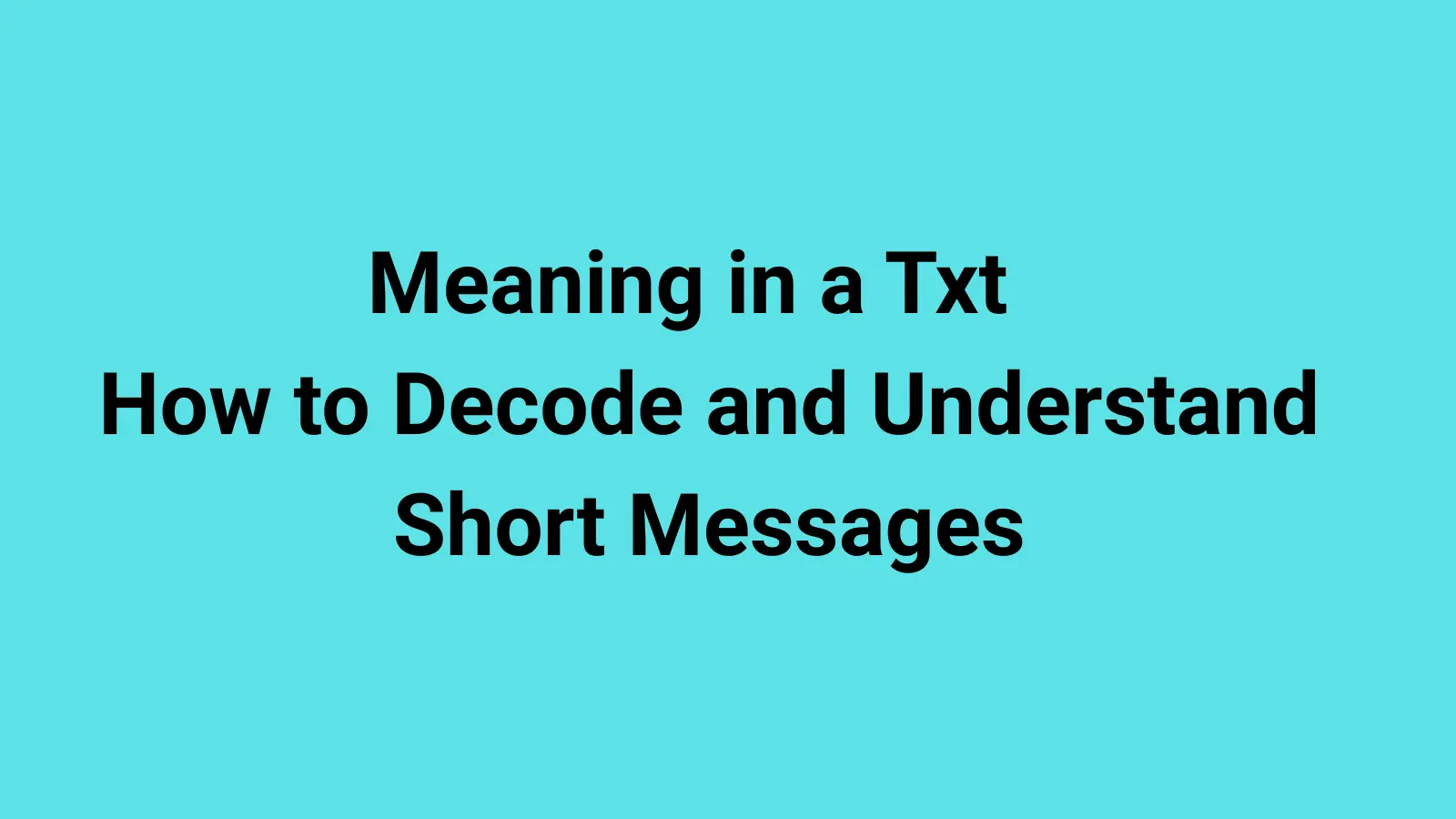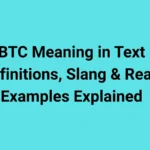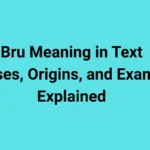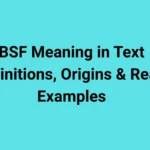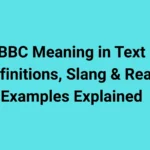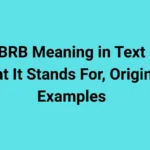In the fast-moving world of texting, words rarely appear in their full form. Instead, we get abbreviations, acronyms, slang, emojis, and shorthand—fast, punchy, and often cryptic to anyone outside the loop.
That’s where the phrase “meaning in a txt” comes in. It’s the question people ask when they get a message full of condensed language and want to know: What does it actually mean?
This guide explains what “meaning in a txt” really is, why short-form language exists, how to decode it, and how to use it naturally in different contexts—from casual chats to professional communication.
You’ll also learn the cultural, emotional, and even generational layers that influence how a text’s meaning comes across.
By the end, you’ll not only understand the meaning in a txt—you’ll be able to find it instantly, respond appropriately, and even teach others the skill.
What Does “Meaning in a Txt” Mean? (Straight to the Point)
At its core, “meaning in a txt” is about interpreting the intention, emotion, and information behind a short-form message.
- Txt = shorthand for “text message” or “texting.”
- Meaning = the actual intent—what the sender really wants to communicate.
Example:
- Message: “wyd” → Literal: “What are you doing?” → Meaning: The sender is either curious about your current activity, wants to hang out, or is starting a conversation.
In texting, meaning is rarely just about the literal words—it’s about tone, timing, relationship, and context.
Why Meaning in a Txt Can Be Tricky
Unlike spoken conversations, texts lack tone of voice, facial expressions, and body language. This makes it easier for messages to be misinterpreted. A short, factual “ok” can mean:
- Agreement
- Mild annoyance
- “I’m busy”
- Indifference
Factors that make “meaning in a txt” hard to read:
- Abbreviations (idk, lol, brb).
- Punctuation (or lack thereof): “Sure.” vs “Sure” vs “sureee.”
- Emoji use: Can soften, emphasize, or flip meaning.
- Cultural/generational differences: Boomers, Millennials, and Gen Z can interpret the same text differently.
- Relationship closeness: A friend’s “u up?” is different from a coworker’s.
How to Find the Meaning in a Txt: Step-by-Step
- Look at the surrounding conversation.
- Was the mood playful, serious, or sarcastic before?
- Was the mood playful, serious, or sarcastic before?
- Check the timing.
- Midnight “hey” is different from 9am “hey.”
- Midnight “hey” is different from 9am “hey.”
- Read punctuation as emotional cues.
- “…” often signals hesitation or a trailing thought.
- ALL CAPS can mean excitement or anger.
- “…” often signals hesitation or a trailing thought.
- Note emojis.
- ❤️ vs 👍 completely changes the message tone.
- ❤️ vs 👍 completely changes the message tone.
- Consider the sender’s usual style.
- Do they always write short? Or is this unusual?
- Do they always write short? Or is this unusual?
- Ask if unclear.
- A quick “Meaning in a txt?” is perfectly fine.
- A quick “Meaning in a txt?” is perfectly fine.
Common Abbreviations You Might Need to Decode the Meaning in a Txt
Here’s a quick reference for common texting abbreviations that change meaning drastically:
| Abbreviation | Meaning | Example Use |
| LOL | Laugh Out Loud | “That video—LOL 😂” |
| BRB | Be Right Back | “brb, grabbing coffee ☕” |
| TBH | To Be Honest | “tbh I didn’t like it” |
| IDK | I Don’t Know | “idk what to eat” |
| IMO/IMHO | In My (Honest/Humble) Opinion | “imo that’s a bad idea” |
| SMH | Shaking My Head | “smh at these prices” |
| FR | For Real | “fr it was the best trip” |
| OMW | On My Way | “omw 🚗💨” |
| WYD | What You Doing? | “wyd rn?” |
| TTYL | Talk To You Later | “gtg ttyl” |
Examples of “Meaning in a Txt” in Real Conversations
Example 1: Romantic Context
- Txt: “wyd” at 11:30 pm.
- Literal: “What are you doing?”
- Meaning: They might be bored, thinking of you, or hinting at wanting to meet up.
Example 2: Work Context
- Txt: “ok.” from your boss after you send a report.
- Literal: Agreement.
- Meaning: Could be acknowledgment, or they’re in a rush. The period makes it feel formal (sometimes cold).
Example 3: Friend Context
- Txt: “lol fine 🙄”
- Literal: They agree.
- Meaning: They’re playfully annoyed but willing to go along.
The Role of Emojis in Shaping the Meaning in a Txt
Emojis can completely alter the interpretation:
- Without emoji: “Thanks.” = Formal, maybe distant.
- With emoji: “Thanks 😊” = Warm, friendly.
- Wrong emoji: “Thanks 😏” = Flirty or sarcastic.
Common tone-shifting emojis:
- 😅 (awkward laugh) → softens criticism.
- 😂 (tears of joy) → shows genuine laughter.
- 😭 (crying) → can mean sadness or exaggerated laughter depending on context.
- ❤️ (heart) → warmth, affection.
- 🙄 (eye roll) → playful annoyance or actual frustration.
Generational Differences in Reading Meaning in a Txt
- Gen Z: Often use lowercase, minimal punctuation, and sarcasm. “ok” might mean “cool, no worries.”
- Millennials: Mix formal and informal; may overuse emojis for tone clarity.
- Gen X/Boomers: More likely to write in full sentences and use punctuation literally.
Example:
- Gen Z “lol” = polite filler, not actual laughter.
- Boomer “lol” = genuine laughter.
How to Write Txts with Clear Meaning
If you want your texts to be understood without confusion:
- Match your tone to the relationship.
- Use punctuation deliberately.
- Add an emoji if tone might be misread.
- Avoid excessive abbreviations with new contacts.
- Confirm important details in full sentences.
Example:
- Instead of: “Meet later?”
- Write: “Meet later? Around 6? 😊” — clear, friendly, and time-specific.
When “Meaning in a Txt” Really Matters
Some situations demand crystal clarity:
- Work updates: Avoid slang unless your workplace culture embraces it.
- Conflict resolution: Spell out feelings; avoid curt one-word replies.
- New relationships: Ambiguity can be misread as disinterest.
- Emergencies: Use full words to avoid confusion.
Misinterpretations: How They Happen
Common causes of getting the meaning wrong:
- Reading in your current mood instead of theirs.
- Missing sarcasm because you lack the shared humor context.
- Ignoring timing (a rushed reply at work vs. a lazy weekend message).
- Forgetting that some people use emojis ironically.
Pro Tips for Decoding “Meaning in a Txt”
- Ask for clarification if stakes are high.
- Check the sender’s past style—is this shorter or longer than usual?
- Look for repetition—are they following up on a previous message?
- Re-read later if your initial reaction feels emotional.
Related Phrases You Might See Alongside “Meaning in a Txt”
- “Meaning of this msg?” — direct request for clarification.
- “What does this mean in chat?” — similar but often for slang/abbreviations.
- “Explain pls” — universal ask for more detail.
- “Context?” — short request to understand intent.
Quick Reference: Emotional Cues in Txts
| Cue | Possible Meaning |
| All caps | Excitement, anger, urgency |
| Repeated letters (“heyyyy”) | Playfulness, affection |
| No punctuation | Casual, quick, or rushed |
| Excess punctuation (“???”) | Urgency, impatience |
| Ellipses (“…”) | Hesitation, trailing thought |
| Double emoji | Strong emphasis on feeling |
Why Understanding Meaning in a Txt Improves Communication
- Prevents misunderstandings that can damage relationships.
- Helps you respond appropriately without overreacting.
- Makes you a better conversationalist both online and offline.
- Builds trust—people feel heard and understood.
Summary: Mastering the Meaning in a Txt
Meaning in a txt is about more than definitions—it’s about reading between the lines. By looking at context, timing, punctuation, emojis, and the sender’s style, you can accurately interpret messages and reply in ways that strengthen your connection.
Conclusion
The next time you receive a short, cryptic message, don’t rush to judgment.
Take a second to read the situation: Who sent it? When? What’s the tone? That’s the secret to cracking the meaning in a txt without awkward misunderstandings.
Texting is fast, but meaning still matters. With the tips in this guide, you’ll never have to wonder again what a three-word or three-letter message really means.
